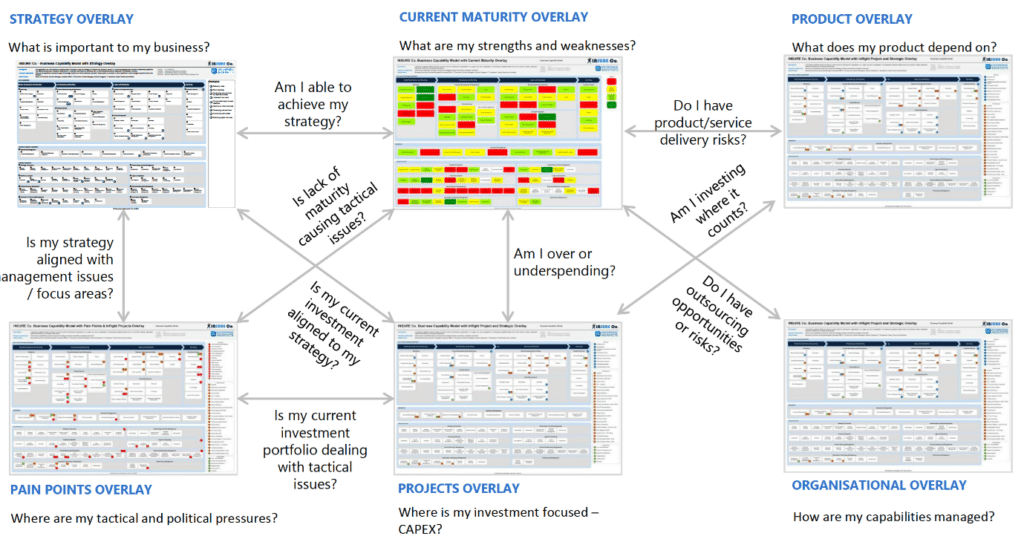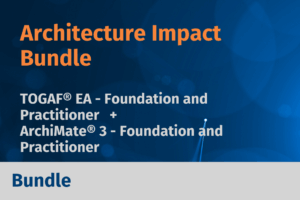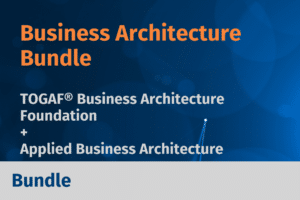Mark Edmead explores this in conjunction with our Applied Business Architecture course
During my most recent Applied Business Architecture course, one of my students asked for a sentence definition of the responsibilities of a Business Architect. While the concept of business architecture is part of the overall enterprise architecture, a Business Architect’s emphasis is on business domain definition and strategy interpretation. I cover more specifics on the benefits of starting an enterprise transformation with the business domain in the article “Do you begin enterprise transformation with the business or with IT?”
A Business Architect interprets and contextualizes strategy for operational needs, develops specific artifacts such as business capability maps and value streams to help bridge the gap between strategy and execution. A Business Architect can also help streamline and rationalize the IT enablement process. In addition to developing specific deliverables, views, and viewpoints, a Business Architect synthesizes and synergies the work of others drawing from disciplines such as strategy development, business analysis, process management, operations, and systems analysis.
A more detailed job description can be found on the Bain Institute website. Here are the highlights of the article:
Business Architect Responsibilities
- Develop a business architecture strategy based on a situational awareness of various business scenarios and motivations.
- Apply a structured business architecture approach and methodology for capturing the key views of the enterprise.
- Capture the tactical and strategic enterprise goals that provide traceability through the organisation and are mapped to metrics that provide ongoing governance.
- Describe the primary business functions of the enterprise and distinguish between customer-facing, supplier-related, business execution and business management functions.
- Define the set of strategic, core and support processes that transcend functional and organisational boundaries; identify and describe external entities such as customers, suppliers, and external systems that interact with the business; and describe which people, resources and controls are involved in the processes.
- Define the data shared across the enterprise and the relationships between those data.
- Capture the relationships among roles, capabilities and business units, the decomposition of those business units into subunits, and the internal or external management of those units.
Business Architect Skills and Qualifications
- A broad, enterprise-wide view of the business and varying degrees of appreciation for strategy, processes and capabilities, enabling technologies, and governance
- The ability to recognize structural issues within the organisation, functional interdependencies and cross-silo redundancies
- The ability to apply architectural principles to business solutions
- The ability to assimilate and correlate disconnected documentation and drawings, and articulate their collective relevance to the organisation and high-priority business issues
- Experience using model-based representations that can be adjusted as required to collect, aggregate or disaggregate complex and conflicting information about the business
- The ability to visualize and create high-level models that can be used in future analysis to extend and mature the business architecture
- Extensive experience planning and deploying both business and IT initiatives
- Experience modelling business processes using a variety of tools and techniques
- Exceptional communication skills and the ability to communicate appropriately at all levels of the organisation; this includes written and verbal communications as well as visualizations
- The ability to act as liaison conveying information needs of the business to IT and data constraints to the business; applies equal conveyance regarding business strategy and IT strategy, business processes and workflow automation, business initiatives and IT initiatives, and benefit realization and service delivery
- Team player able to work effectively at all levels of an organisation with the ability to influence others to move toward consensus
- Strong situational analysis and decision-making abilities
In the Applied Business Architecture course, we take this a step further. We answer the question: “how do we go from strategy to execution?”. We answer this question by using Capability Maturity Overlays. In each overlay, there are questions we ask to get a better understanding of specific stakeholder concerns. Identifying the stakeholders and understanding their concerns is critical and a sometimes overlooked activity. The overlays are:
Strategy Overlay – What is important to my business?
Current Maturity Overlay – What are my strengths and weakness?
Pain Points Overlay – Where are my tactical and political pressures?
Process Overlay – Where is my investment focused?
Product Overlay – What does my product depend on?
organisational overlay – How are my capabilities managed?

Figure 1: Capability Model Overlays (Copyright© EA Learning Pty Ltd 2021)
To better understand the stakeholder concerns, we need to dig deeper into the relationships between overlays as shown in Figure 1. In beginning this assessment, we start with the Strategy Overlay. The base model is the Business Capability Model (BCM). The BCM is a key architecture viewpoint that depicts the capabilities an enterprise requires to deliver upon its strategy. Beyond helping highlight an enterprises capabilities, models may provide additional value by clarifying how mature they are by evaluating against multiple dimensions such as people, process, information, and technology. These capabilities are defined at different levels. When mapping capabilities, it is customary to start from the top-down, starting with aggregate level, to the capability area, and moving to the sub-capabilities and process tasks.
| Level | Hierarchy |
| 0 | Capability area |
| 1 | Capability group |
| 2 | Capability |
| 3 | Sub-capability |
| 4 | Tasks |
The connection between the Strategic Overlay and the Current Maturity Overlays helps answer the question: “Am I able to achieve my strategy?” Answering this question makes sense after the business architect captures the tactical and strategic enterprise goals. If the enterprise possesses any weak maturity areas, it is unlikely the strategy can be achieved. The business architect should then determine the desired capability needed to realize the strategy.
The other overlay relationship is between the Strategy Overlay and Pain Points Overlay which looks at how and if the strategy is aligned with management issues and focus areas (a possible stakeholder concern). Which brings up the next concern: “Is my lack of maturity causing tactical issues?” This means if the organisation has a low maturity in a key capability area then it is possible that this weakness can cause pain points restricting the company from achieving its strategic goals.
Now that we have addressed the Strategic, Current Maturity, and Pain Points overlays, the next overlay to consider is the Projects Overlay.
The three main questions here are: “Is my current portfolio dealing with tactical issues? Is my current investment aligned with my strategy? And am I over or underspending?” organisations need to “audit” not only their planned projects/initiatives but also their projects that are “in-flight.” As an auditor, I’ve performed countless audits where the organisation has not evaluated its planned and in-flight projects. The Standish Group (https://www.standishgroup.com/) research shows a staggering 31.1% of projects will be cancelled before they ever get completed. Further results indicate 52.7% of projects will cost 189% of their original estimates. On the success side, the average is only 16.2% for software projects that are completed on- time and on-budget. So, the question is, are your planned or in-flight projects investments aligned with the strategic intent? Do these projects address the identified pain points?
Is the lack of maturity causing these pains? Do you have a high level of capability maturity that is not necessary to achieve your strategic goal (a waste of people, process, information and technology)?
As an example, let’s say that during the evaluation of the Current Maturity it is determined there are weaknesses in your capabilities. This leads to the next question: “Do I have product/service delivery risks?” If the organisation is lacking capabilities or needs to improve the existing capabilities, then we ask “Do I have outsourcing opportunities or risks? In the Product Overlay, we look at how the capability maturity affects the product or service delivery. In the organisation Overlay, we determine if we are adequately managing these capabilities.
Let us discuss a bit more about capabilities. The primary objective of the business capability model is to frame the range of critical choices and provide a systematic way to prioritize investments across the dimensions of a capability. As we previously stated, the dimensions are People, Process, Information, and Technology. I would also argue that there is a 5th dimension – Governance. Governance relates to the compilation of clear roles and responsibilities, decision policies to facilitate integrations within and across other capabilities, functions, and business partners.
To achieve that, enterprise capabilities are classified into categories such as strategic, core, and foundational. This categorization drives focus and where the enterprise should concentrate its investments. Let’s start with basic capabilities. Basic capabilities keep the business afloat by aiding in the completion of daily operations. A core competency is a concept in management theory introduced by C. K. Prahalad and Gary Hamel. It can be defined as “a harmonized combination of multiple resources and skills that distinguish a firm in the marketplace” and therefore are the foundation of companies’ competitiveness. Strategic capabilities serve as the basis for competitive advantage; they are required to win. These capabilities must be distinctive versus competitors and either meaningful to customers or a source of economic advantage.
Now that we discussed the foundational elements of business architecture, let’s summarize the main responsibilities of the business architect:
- Capability uplift: Transition Planning and Roadmap
- Advocacy and communication of the architecture, roadmap and rationale
- Business architecture and project portfolio execution, including governance and ongoing refinement and change management.
So here it is – Applied Business Architecture in action. This is just one of the many methods and techniques in this workshop. If you ever wanted to learn how to bridge the gap between strategy and execution, this is the course for you. Read more and register today!
By Mark Edmead
LinkedIn
Copyright © 2021 Mark Edmead and EA Learning Pty Ltd




































































